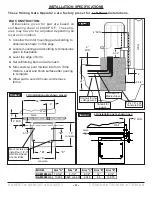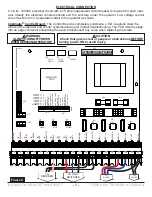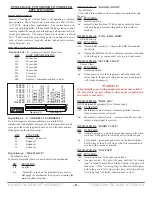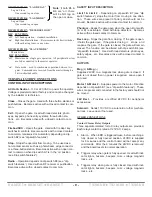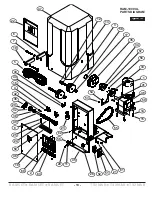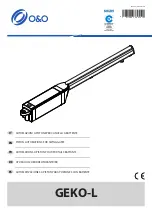
R A M S E T
z
R A M S E T
z
R A M S E T
RA
MS
ET
z
RA
MS
ET
z
RA
MS
ET
- 2 -
Installation should be done by a qualified installer only.
Prior to Installation, the following must be
observed: (per UL 325 51.8.4)
a)
Install the vehicular gate operator only when:
1) The Vehicular Gate Operator is appropri-
ate for the construction of the gate and
the usage Class of the gate,
2) All openings of a horizontal slide gate are
guarded or screened from the bottom of
the gate to a minimum of 4 feet (1.2 m)
above the ground to prevent a 2-1/4 inch
(57.15 mm) diameter sphere from pass-
ing through the openings anywhere in the
gate, and in that portion of the adjacent
fence that the gate covers in the open
position.
3) All exposed pinch points are eliminated or
guarded, and
4) Guarding is supplied for exposed rollers.
b)
The Vehicular Gate Operator is intended for
installation only on gates used for vehicles.
Pedestrians must be supplied with a separate
access opening.
c)
The gate must be installed in a location so
that enough clearance is supplied between
the gate and adjacent structures when open-
ing and closing to reduce the risk of entrap-
ment. Swinging gates shall not open into
public access areas.
d)
The gate must be properly installed and work
freely in both directions prior to the installa-
tion of the Vehicular Gate Operator. Do not
over-tighten the operator clutch to compen-
sate for a damaged gate.
e)
Controls must be far enough from the gate so
that the user is prevented from coming in
contact with the gate while operating the con-
trols. Controls intended to be used to reset a
Vehicular Gate Operator after 2 sequential
activations of the entrapment protection
device or devices must be located in the line-
of-sight of the gate. Outdoor or easily acces-
sible controls shall have a security feature to
prevent unauthorized use.
f)
All warning signs and placards must be
installed where visible in the area of the gate.
g)
For Vehicular Gate Operators utilizing a non-
contact sensor in accordance with 30A.1.1
Type B1 non-contact sensor (photo electric
sensor or the equivalent)
1) See instructions on the placement of
non-contact sensors for each Type of
application,
2) Care shall be exercised to reduce the risk
of nuisance tripping, such as when a
vehicle, trips the sensor while the gate is
still moving, and
3) One or more non-contact sensors shall
be located where the risk of entrapment
or obstruction exists, such as the perime-
ter reachable by a moving gate or barrier.
h)
For a Vehicular Gate Operator utilizing a con-
tact sensor in accordance with 30A.1.1
1) One or more contact sensors shall be
located at the leading edge, trailing edge,
and postmounted both inside and outside
of a vehicular horizontal slide gate.
2) One or more contact sensors shall be
located at the bottom edge of a vehicular
vertical lift gate.
3) One or more contact sensors shall be
located at the pinch point of a vehicular
vertical pivot gate.
4) A hardwired contact sensor shall be
located and its wiring arranged so that
the communication between the sensor
and the vehicular gate operator is not
subjected to mechanical damage.
5) A wireless contact sensor such as one
that transmits radio frequency (RF) sig-
nals to the vehicular gate operator for
entrapment protection functions shall be
located where the transmission of the
signals are not obstructed or impeded by
building structures, natural landscaping
or similar obstruction. A wireless contact
sensor shall function under the intended
end-use conditions.





